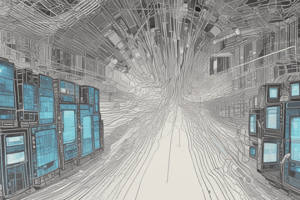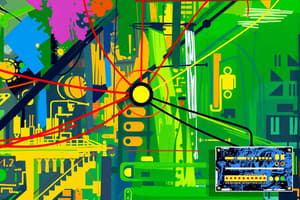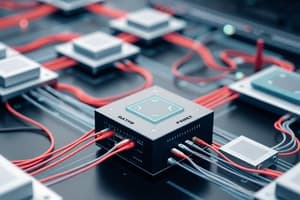Podcast
Questions and Answers
What function does a router perform in a network?
What function does a router perform in a network?
- Modulates and demodulates signals
- Routes data packets between devices and networks (correct)
- Broadcasts data to all connected devices
- Connects devices within the same network
Which device is specifically designed to extend a wired network by adding Wi-Fi capability?
Which device is specifically designed to extend a wired network by adding Wi-Fi capability?
- Repeater
- Modem
- Router
- Access Point (AP) (correct)
What is the primary role of a hub in a network?
What is the primary role of a hub in a network?
- Routes data packets between networks
- Broadcasts data to all connected devices (correct)
- Filters traffic and reduces network congestion
- Connects different networks together
Which of the following operates at the physical layer (Layer 1)?
Which of the following operates at the physical layer (Layer 1)?
What does a firewall do in a network?
What does a firewall do in a network?
What type of device is a modem?
What type of device is a modem?
Which network device is used to connect and filter traffic between network segments?
Which network device is used to connect and filter traffic between network segments?
What is true about a Network Interface Card (NIC)?
What is true about a Network Interface Card (NIC)?
Flashcards are hidden until you start studying
Study Notes
Network Devices
-
Router
- Connects different networks together.
- Routes data packets between devices and networks.
- Can perform Network Address Translation (NAT) and firewall functions.
-
Switch
- Connects devices within the same network (Local Area Network - LAN).
- Operates at the data link layer (Layer 2) or network layer (Layer 3).
- Uses MAC addresses to forward data to the correct device.
-
Hub
- Basic device for connecting multiple Ethernet devices.
- Operates at the physical layer (Layer 1).
- Broadcasts data to all connected devices; no data filtering.
-
Access Point (AP)
- Extends a wired network by adding Wi-Fi capability.
- Connects wireless devices to a wired network.
- Can function as a standalone device or as part of a network.
-
Modem
- Connects a network to the Internet service provider (ISP).
- Modulates and demodulates signals for data transmission.
- Can be standalone or combined with a router.
-
Firewall
- Monitors and controls incoming and outgoing network traffic.
- Can be hardware-based, software-based, or a combination of both.
- Provides security by establishing a barrier between trusted and untrusted networks.
-
Network Interface Card (NIC)
- Hardware that allows a device to connect to a network.
- Can be wired (Ethernet) or wireless (Wi-Fi).
- Each NIC has a unique MAC address for identification.
-
Repeater
- Regenerates and amplifies signals to extend the range of a network.
- Operates at the physical layer (Layer 1).
- Useful in long-distance connections to prevent signal degradation.
-
Bridge
- Connects and filters traffic between two or more network segments.
- Operates at the data link layer (Layer 2).
- Reduces traffic by dividing a large network into smaller, manageable segments.
-
Gateway
- Acts as a "gate" between two networks with different protocols.
- Translates communication between different network architectures.
- Essential for connecting enterprise networks to the Internet or other networks.
Network Devices Overview
-
Router
- Connects multiple networks and routes data packets effectively.
- Capable of performing Network Address Translation (NAT) and other firewall functions.
-
Switch
- Facilitates communication between devices on the same Local Area Network (LAN).
- Functions primarily at the data link layer (Layer 2) or network layer (Layer 3) using MAC addresses to direct data.
-
Hub
- Basic networking device that connects multiple Ethernet devices in a network.
- Operates at the physical layer (Layer 1) and broadcasts data without filtering to all connected devices.
-
Access Point (AP)
- Enhances a wired network by enabling Wi-Fi connectivity.
- Connects wireless devices to a wired backbone and can operate independently or within a network.
-
Modem
- Serves as the interface between a local network and an Internet Service Provider (ISP).
- Modulates and demodulates signals for effective data transmission; can operate as a standalone device or in conjunction with a router.
-
Firewall
- Controls and monitors both incoming and outgoing network traffic to provide security.
- Can be implemented as hardware, software, or a hybrid; establishes a protective barrier between trusted and untrusted networks.
-
Network Interface Card (NIC)
- Essential hardware component that enables devices to connect to a network.
- Available in wired (Ethernet) or wireless (Wi-Fi) formats, each NIC possesses a unique MAC address for identification.
-
Repeater
- Extends network coverage by regenerating and amplifying signals.
- Operates at the physical layer (Layer 1) and is critical for maintaining signal integrity over long distances.
-
Bridge
- Connects and filters traffic between distinct network segments.
- Works at the data link layer (Layer 2), reduces congestion by partitioning a large network into smaller segments.
-
Gateway
- Serves as an intermediary between two networks that utilize different protocols.
- Translates communication between diverse network architectures, playing a vital role in connecting enterprise networks to the Internet or other network environments.
Studying That Suits You
Use AI to generate personalized quizzes and flashcards to suit your learning preferences.




